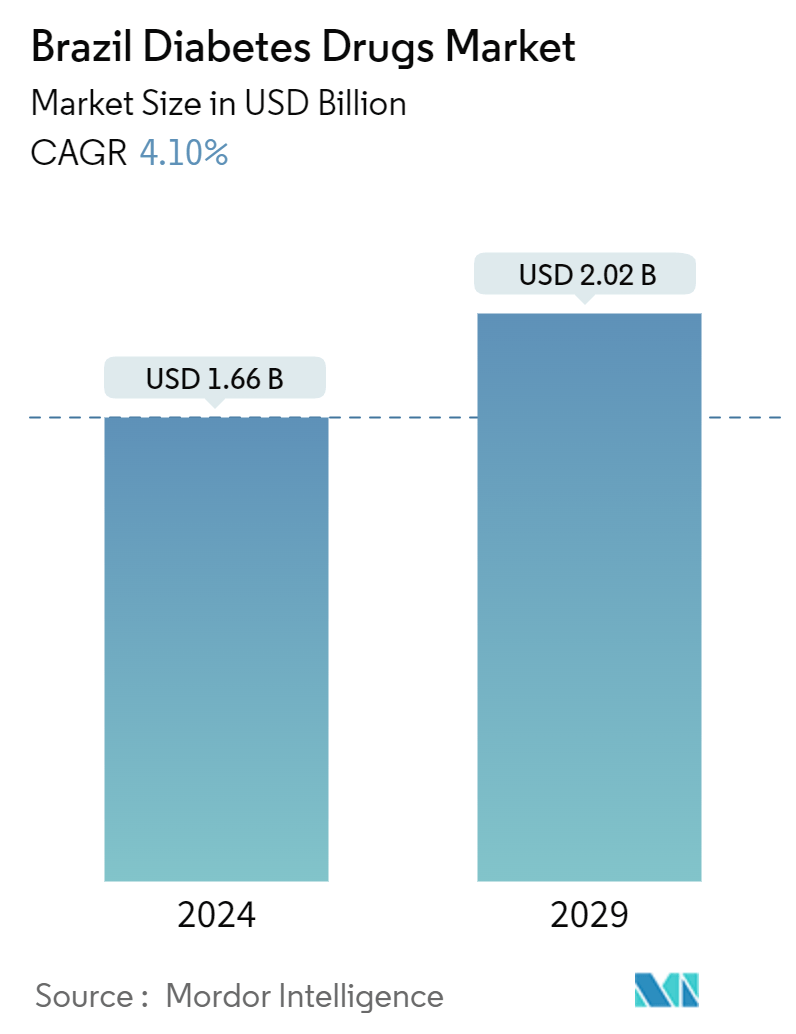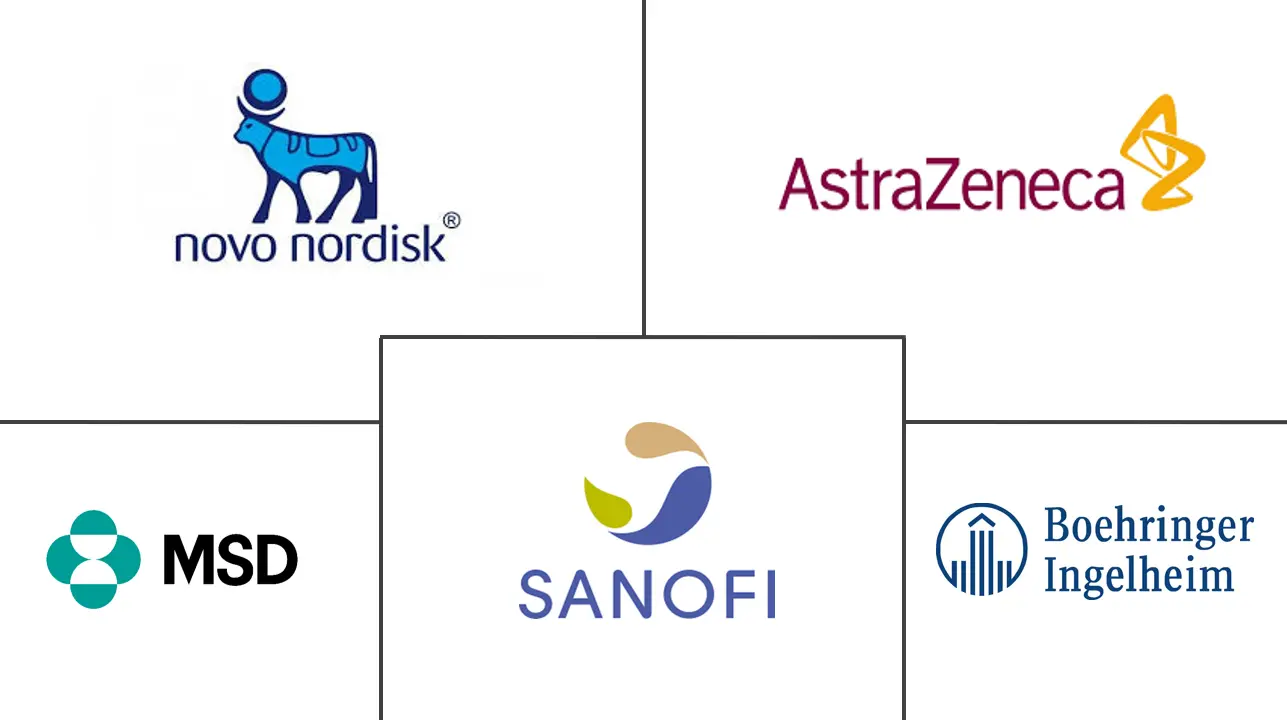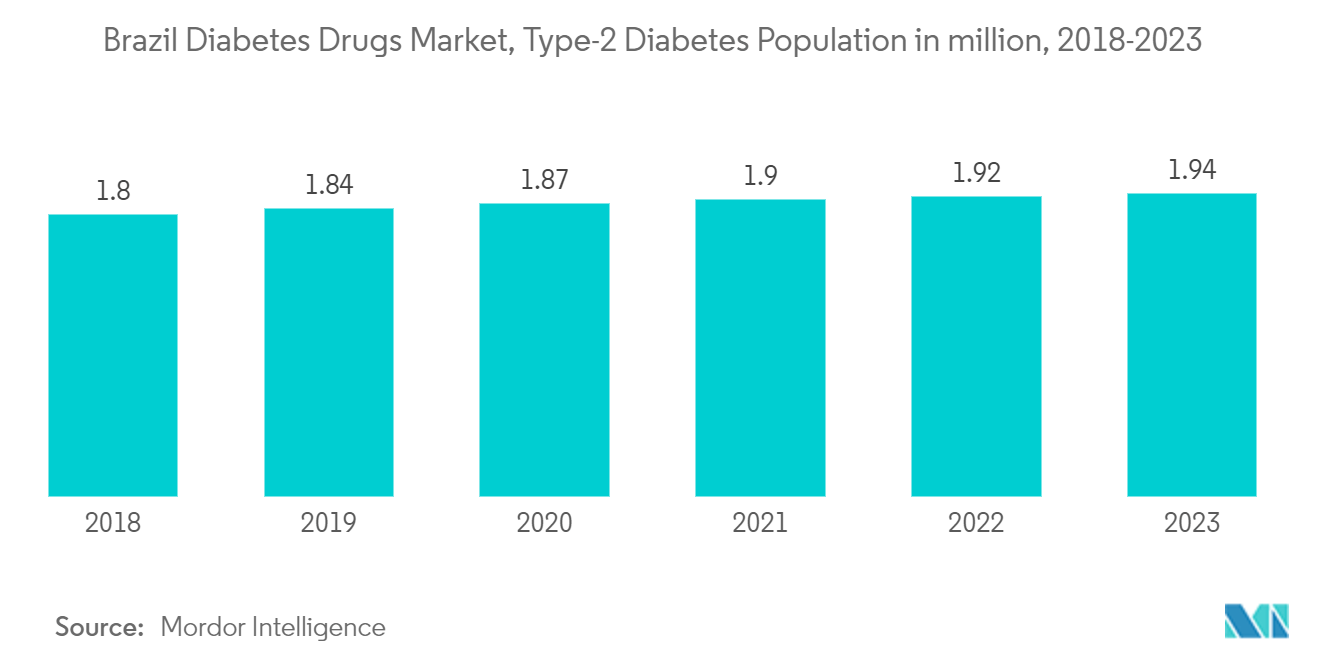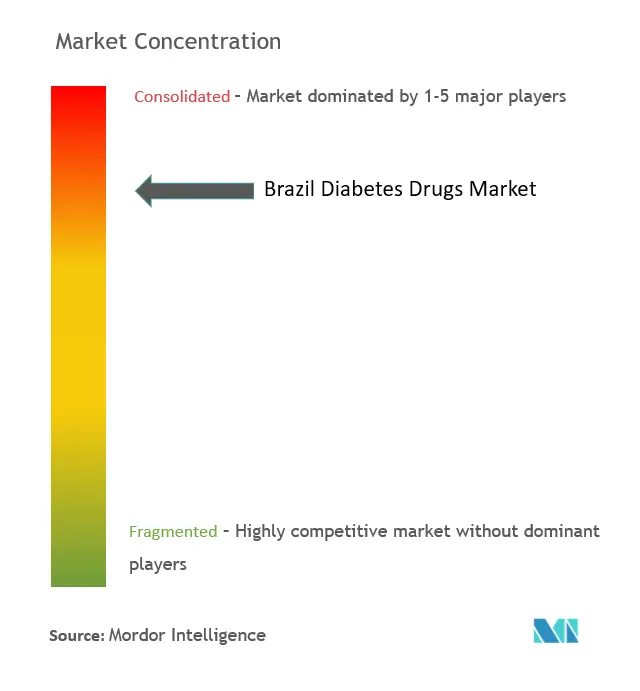Brazil Diabetes Drugs Market Size

| Study Period | 2018 - 2029 |
| Base Year For Estimation | 2023 |
| Forecast Data Period | 2024 - 2029 |
| Market Size (2024) | USD 1.66 Billion |
| Market Size (2029) | USD 2.02 Billion |
| CAGR (2024 - 2029) | 4.10 % |
Major Players
*Disclaimer: Major Players sorted in no particular order |
Brazil Diabetes Drugs Market Analysis
The Brazil Diabetes Drugs Market size is estimated at USD 1.66 billion in 2024, and is expected to reach USD 2.02 billion by 2029, growing at a CAGR of 4.10% during the forecast period (2024-2029).
Diabetes is a significant health problem and one of the extraordinary challenges for healthcare systems all over Brazil. The disease's growing incidence, prevalence, and progressive nature encouraged the development of new drugs to provide additional treatment options for diabetic patients. The roll-out of many new products, increasing international research collaborations in technology advancement, and increasing awareness about diabetes among people are some of the market opportunities for the players in the diabetes drugs market.
According to IDF Diabetes, 15.7 million adults about 10.5% are currently living with diabetes in Brazil or one in ten adults. The cost of diabetes-related health expenditure in Brazil is the third highest in the world, at 42.9 billion USD. In addition, 18 million adults around 11.9% have Impaired Glucose Tolerance which places them at high risk of developing type 2 diabetes. 32% of people living with diabetes in Brazil are undiagnosed. Additional data on glycaemic control in Brazil show that only 25% met the therapeutic goal of glycated hemoglobin (HbA1c) less than 7% before the pandemic, as recommended by the Brazilian Diabetes Society (SBD).
When diabetes is undetected or inadequately treated, people with diabetes are at risk of serious and life-threatening complications, such as heart attack, stroke, kidney failure, blindness, and lower-limb amputation. These result in reduced quality of life and higher healthcare costs and lead to a greater need for access to care.
Brazil has implemented a set of reforms over the past to improve the distribution of doctors, develop new forms of service organization, introduce new financing models, and implement a range of quality improvement initiatives and policy frameworks to overcome risk factors such as obesity and emerging pandemic threats. This also highlights opportunities for continuing and expanding innovations in the delivery of diabetes care.
Brazil Diabetes Drugs Market Trends
The oral anti-diabetic drugs segment holds the highest market share in the Brazil Diabetes Drugs Market in the current year
Oral Anti-Diabetic Drugs are available internationally and are recommended for use when escalation of treatment for type 2 diabetes is required along with lifestyle management. Oral agents are typically the first medications used in treating type 2 diabetes due to their wide range of efficacy, safety, and mechanisms of action. Anti-diabetic drugs help diabetes patients control their condition and lower the risk of diabetes complications.
People with diabetes may need to take anti-diabetic drugs for their whole lives to control their blood glucose levels and avoid hypoglycemia and hyperglycemia. Oral anti-diabetic agents present the advantages of easier management and lower cost. So they became an attractive alternative to insulin with better acceptance, which enhances adherence to the treatment.
Brazil witnessed an alarming increase in the prevalence of diabetes in recent years. Patients with diabetes require many corrections throughout the day to maintain nominal blood glucose levels, such as oral anti-diabetic medication or ingestion of additional carbohydrates by monitoring their blood glucose levels. The rate of newly diagnosed Type 1 and Type 2 diabetes cases is seen to increase. The rapidly increasing incidence and prevalence of diabetic patients and healthcare expenditure are indications of the increasing diabetic drugs usage.
According to IDF the cost of diabetes-related health expenditure in Brazil is the third highest in the world, at USD 42.9 billion. In addition, 18 million adults, around 11.9%, contain Impaired Glucose Tolerance, which places them at high risk of developing type 2 diabetes. 32% of people living with diabetes in Brazil are undiagnosed. Additional data on glycaemic control in Brazil show that only 25% met the therapeutic goal of glycated hemoglobin (HbA1c), less than 7% before the pandemic, as recommended by the Brazilian Diabetes Society (SBD). The Government partnered with numerous private companies to utilize their supply chain (manufacturing, distribution, and retailers) to ensure low drug prices.
Owing to the factors above, the market will likely continue to grow.

The Dipeptidyl peptidase - 4 (DPP-4) inhibitors Segment holds the highest market share in the Brazil Diabetes Drugs Market in the current year
Dipeptidyl peptidase 4 (DPP-4) inhibitors are a class of medicine that lower high blood glucose levels and treat type 2 diabetes. Dipeptidyl-peptidase 4 inhibitors include glucose regulatory actions by prolonging the effects of GLP-1 and GIP, ultimately increasing glucose-mediated insulin and suppressing glucagon secretion. Beside the glucose-lowering properties of DPP4 inhibitors, emerging evidence suggests that incretin-based therapies may also positively impact inflammation, cardiovascular and hepatic health, sleep, and the central nervous system.
Over the past decade, two important classes entered this market: dipeptidyl peptidase-4 inhibitors (DPP-4) and sodium-glucose cotransporter-2 inhibitors (SGLT-2). These agents work in various ways to reduce blood sugar levels in people with type 2 diabetes. Some stimulate insulin secretion by the pancreas, and others improve the responsiveness of cells to insulin or prevent glucose production by the liver.
Others slow the absorption of glucose after meals. Also, the use of oral anti-diabetes drugs is rising because new-generation oral drugs, such as DPP-4 and SGLT-2, reduce the rate of CV risk in diabetes patients.
In Brazil, the public health system (Sistema Único de Saúde; SUS) is progressively increasing the assistance available for individuals with diabetes. The Ministry of Health established a list of medications and supplies the Brazilian Health System (SUS) provided to patients with diabetes. The various initiatives by the Brazilian government are expected to drive the market's growth.

Brazil Diabetes Drugs Industry Overview
The Brazil Diabetes Drugs Market is moderately consolidated, with major manufacturers, namely Eli Lilly, Sanofi, Novo Nordisk, AstraZeneca, and other generic players, holding a presence in the region. A major share of the market is held by manufacturers concomitant with strategy-based M&A operations and constantly entering the market to generate new revenue streams and boost existing ones.
Brazil Diabetes Drugs Market Leaders
-
AstraZeneca
-
MSD
-
Boehringer Ingelheim
-
Novo Nordisk A/S
-
Sanofi Aventis
*Disclaimer: Major Players sorted in no particular order

Brazil Diabetes Drugs Market News
- Septmber 2023: Anvisa, Brazil's federal health regulator, has granted approval for tirzepatide, an injectable medication designed to enhance blood sugar management in adults diagnosed with Type 2 diabetes. Manufactured by the renowned U.S. pharmaceutical company Eli Lilly, tirzepatide is marketed under the brand name Mounjaro.
- March 2022: Oramed announced ORMD-0801 (a new molecule) is being evaluated in two pivotal Phase 3 trials and can be the first oral insulin capsule with the most convenient and safest way to deliver insulin therapy. This drug is expected to be a game-changer in the insulin and oral anti-diabetes drugs markets.
Brazil Diabetes Drugs Market Report - Table of Contents
1. INTRODUCTION
1.1 Study Assumptions and Market Definition
1.2 Scope of the Study
2. RESEARCH METHODOLOGY
3. EXECUTIVE SUMMARY
4. MARKET DYNAMICS
4.1 Market Overview
4.2 Market Drivers
4.3 Market Restraints
4.4 Porter's Five Forces Analysis
4.4.1 Bargaining Power of Suppliers
4.4.2 Bargaining Power of Consumers
4.4.3 Threat of New Entrants
4.4.4 Threat of Substitute Products and Services
4.4.5 Intensity of Competitive Rivalry
5. MARKET SEGMENTATION
5.1 Insulins
5.1.1 Basal or Long Acting Insulins
5.1.1.1 Lantus (Insulin Glargine)
5.1.1.2 Levemir (Insulin Detemir)
5.1.1.3 Toujeo (Insulin Glargine)
5.1.1.4 Tresiba (Insulin Degludec)
5.1.1.5 Basaglar (Insulin Glargine)
5.1.2 Bolus or Fast Acting Insulins
5.1.2.1 NovoRapid/Novolog (Insulin Aspart)
5.1.2.2 Humalog (Insulin Lispro)
5.1.2.3 Apidra (Insulin Glulisine)
5.1.3 Traditional Human Insulins
5.1.3.1 Novolin/Actrapid/Insulatard
5.1.3.2 Humulin
5.1.3.3 Insuman
5.1.4 Biosimilar Insulins
5.1.4.1 Insulin Glargine Biosimilars
5.1.4.2 Human Insulin Biosimilars
5.2 Oral Anti-diabetic drugs
5.2.1 Biguanides
5.2.1.1 Metformin
5.2.2 Alpha-Glucosidase Inhibitors
5.2.2.1 Alpha-Glucosidase Inhibitors
5.2.3 Dopamine D2 receptor agonist
5.2.3.1 Bromocriptin
5.2.4 SGLT-2 inhibitors
5.2.4.1 Invokana (Canagliflozin)
5.2.4.2 Jardiance (Empagliflozin)
5.2.4.3 Farxiga/Forxiga (Dapagliflozin)
5.2.4.4 Suglat (Ipragliflozin)
5.2.5 DPP-4 inhibitors
5.2.5.1 Onglyza (Saxagliptin)
5.2.5.2 Tradjenta (Linagliptin)
5.2.5.3 Vipidia/Nesina(Alogliptin)
5.2.5.4 Galvus (Vildagliptin)
5.2.6 Sulfonylureas
5.2.6.1 Sulfonylureas
5.2.7 Meglitinides
5.2.7.1 Meglitinides
5.3 Non-Insulin Injectable drugs
5.3.1 GLP-1 receptor agonists
5.3.1.1 Victoza (Liraglutide)
5.3.1.2 Byetta (Exenatide)
5.3.1.3 Bydureon (Exenatide)
5.3.1.4 Trulicity (Dulaglutide)
5.3.1.5 Lyxumia (Lixisenatide)
5.3.2 Amylin Analogue
5.3.2.1 Symlin (Pramlintide)
5.4 Combination drugs
5.4.1 Insulin combinations
5.4.1.1 NovoMix (Biphasic Insulin Aspart)
5.4.1.2 Ryzodeg (Insulin Degludec and Insulin Aspart)
5.4.1.3 Xultophy (Insulin Degludec and Liraglutide)
5.4.2 Oral Combinations
5.4.2.1 Janumet (Sitagliptin and Metformin)
6. MARKET INDICATORS
6.1 Type-1 Diabetic Population
6.2 Type-2 Diabetic Population
7. COMPETITIVE LANDSCAPE
7.1 COMPANY PROFILES
7.1.1 Novo Nordisk A/S
7.1.2 Takeda
7.1.3 Pfizer
7.1.4 Eli Lilly
7.1.5 Janssen Pharmaceuticals
7.1.6 Astellas
7.1.7 Boehringer Ingelheim
7.1.8 Merck And Co.
7.1.9 AstraZeneca
7.1.10 Bristol Myers Squibb
7.1.11 Novartis
7.1.12 Sanofi Aventis
- *List Not Exhaustive
7.2 COMPANY SHARE ANALYSIS
7.2.1 Novo Nordisk A/S
7.2.2 Sanofi Aventis
7.2.3 Eli Lilly
7.2.4 Merck And Co.
7.2.5 Others
8. MARKET OPPORTUNITIES AND FUTURE TRENDS
Brazil Diabetes Drugs Industry Segmentation
Diabetes Drugs are used to manage diabetes mellitus by lowering the glucose level in the blood. The Brazil Diabetes Drugs Market is segmented into insulin drugs, oral anti-diabetic drugs, non-insulin injectable drugs, and combination drugs. The report offers the value (in USD) and volume (in units) for the above segments.
| Insulins | |||||||
| |||||||
| |||||||
| |||||||
|
| Oral Anti-diabetic drugs | ||||||
| ||||||
| ||||||
| ||||||
| ||||||
| ||||||
| ||||||
|
| Non-Insulin Injectable drugs | |||||||
| |||||||
|
| Combination drugs | |||||
| |||||
|
Brazil Diabetes Drugs Market Research FAQs
How big is the Brazil Diabetes Drugs Market?
The Brazil Diabetes Drugs Market size is expected to reach USD 1.66 billion in 2024 and grow at a CAGR of 4.10% to reach USD 2.02 billion by 2029.
What is the current Brazil Diabetes Drugs Market size?
In 2024, the Brazil Diabetes Drugs Market size is expected to reach USD 1.66 billion.
Who are the key players in Brazil Diabetes Drugs Market?
AstraZeneca, MSD, Boehringer Ingelheim, Novo Nordisk A/S and Sanofi Aventis are the major companies operating in the Brazil Diabetes Drugs Market.
What years does this Brazil Diabetes Drugs Market cover, and what was the market size in 2023?
In 2023, the Brazil Diabetes Drugs Market size was estimated at USD 1.59 billion. The report covers the Brazil Diabetes Drugs Market historical market size for years: 2018, 2019, 2020, 2021, 2022 and 2023. The report also forecasts the Brazil Diabetes Drugs Market size for years: 2024, 2025, 2026, 2027, 2028 and 2029.
Brazil Diabetes Drugs Industry Report
Statistics for the 2024 Brazil Diabetes Drugs market share, size and revenue growth rate, created by Mordor Intelligence™ Industry Reports. Brazil Diabetes Drugs analysis includes a market forecast outlook 2029 and historical overview. Get a sample of this industry analysis as a free report PDF download.



